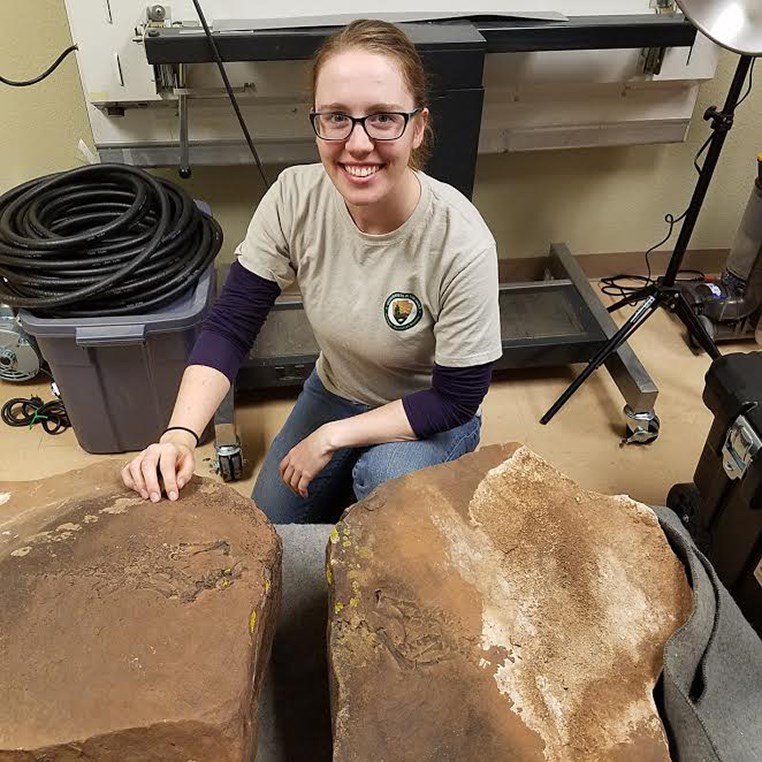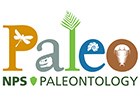Part of a series of articles titled Park Paleontology News - Vol. 09, No. 1, Spring 2017.
Article
Paleontology Intern Profile - Emily Thorpe

NPS Photo
I graduated from Winona State University in Winona, MN in May of 2016 with a BS in Geoscience: Environmental Science. During school I took as many opportunities as I could and my internship here at Salinas Pueblo Missions was not my first Geoscientist-in-the-Parks (GIP) internship in the search for paleontology experience. In the summer of 2015 I worked at Florissant Fossil Beds National Monument in Colorado. After that experience in a park founded largely because of its paleontological resources, what interested me most about the position at Salinas Pueblo Missions was the opportunity to work in a park that had not yet been explored for paleontological resources. The geology underlying the park has been studied for decades and the paleontology in the area has been pretty well documented but no one had yet examined the units within the park boundaries.
The three park sites (Quarai, Abo, and Gran Quivira) are located various distances from the central Salinas Pueblo Missions headquarters in Mountainair, NM. Because of the park’s cultural history it is not surprising that the vast majority of fossils previously discovered at these park units were discovered during excavations of pueblo mounds and retain a lot of cultural significance.
The geology of central New Mexico is early Permian (approx. 280 million years) and overlain by various types of Quaternary alluvium. The Permian environment ranges from equatorial alluvial floodplains to shallow sea environments. From youngest to oldest the units exposed within the park are the Abo Formation, the Yeso Group (consisting of the Arroyo de Alamillo and Los Vallos Formations) and the San Andres Limestone. Terrestrial deposits preserve invertebrate traces, invertebrate and vertebrate trackways (Diplichnites, Batrachichnus, and Dromopus), plant fossils (Walchia piniformis, Supaia thinnfeldioides, and Dicranophyllum), and a vertebrate skeleton, while the marine deposits preserve marine invertebrates (brachiopods, bivalves, gastropods, and cephalopods). There have also been Quaternary paleontological resources discovered within park boundaries, but they are either lost or stored at the Western Archaeological Conservation Center (WACC) in Tucson, AZ.
The discovery of all these specimens is rewriting the history of this park, but the most notable of these finds is the Permian vertebrate skeleton. The geologic units surrounding its location are terrestrial and though trackways and plants have been discovered in locations around the state, body fossils are rare. This particular find is the articulated lower half of an early Permian reptile. As of now it is unknown if this is a new species or one that is known from other localities.
Discovering this specimen was completely unexpected. I was out surveying with Ron Fields (Integrated Resource Specialist at Salinas Pueblo Missions) and the day was winding down. We had begun to head back towards the vehicle when Ron stopped and called me over saying “Emily, I’ve got bone!” Of course I was skeptical. Vertebrates are rare in these formations and even less so this high in the stratigraphic section. When I saw it for myself my jaw dropped and I couldn’t contain my excitement. Not only was it a skeleton (the imprint of one at least), but it was articulated and there were two counterparts. Visible in each are hind limb bones (some broken), posterior vertebrae, hand and finger bones, and on one counterpart the tail is visible almost to the very tip. With the help of the Salinas Pueblo Missions maintenance staff each of the counterparts of this specimen was safely collected, accessioned and catalogued. We have also confirmed that this is the first vertebrate fossil to be discovered in the Yeso Group and more specifically in the Arroyo de Alamillo Formation. We have taken photogrammetric images of each counterpart in order to make 3D models of the stones and see details that may not be visible with the naked eye. Further study of this specimen will be conducted by Dr. Spencer Lucas of the New Mexico Museum of Natural History and Science, Dr. Dave Berman of the Carnegie Museum, and me. I am so excited to be a part of this discovery and its continued study.
My work here at Salinas Pueblo Missions National Monument has not only allowed me to increase my own personal experience, but has resulted in significant scientific discovery that can be shared with all of the visitors to this beautiful park. It is so much more than I expected when I arrived in this remote part of New Mexico, but this opportunity has turned into something amazing and I am so very proud to be able to share it.
Last updated: April 22, 2020

